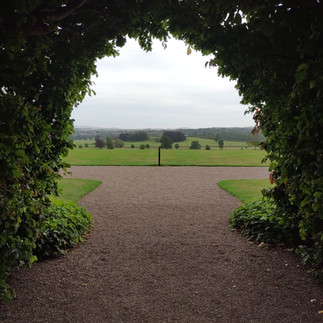Floors Castle: Scottish Sophistication with an American Twist
- Wee Walking Tours

- Oct 31, 2021
- 7 min read
Updated: Apr 5, 2024
This week we head down to the Scottish Borders to visit an extraordinary historical Scottish landmark- Floors Castle. Being the largest occupied house in Scotland, you can imagine the incredible history and stories it holds. Join us as we bring you on a virtual visit to this fascinating castle that has been home to the Dukes of Roxburghe since the 1720s.

The grandeur of Floors Castle cannot be overstated. I knew from online photos that it was large, but you can’t fully appreciate its scale until you see it in person. On the day of our visit, as we walked around to the front of the Castle, my jaw dropped as turret after turret revealed itself. Floors Castle certainly excels in the sweeping architecture department.
Yet, the Castle wasn’t always so grand, and it originated as a tower house in the 15th century. By 1721, the size of the house was greatly increased as the Edinburgh architect, William Adam, was commissioned to design a country mansion befitting the status of the 1st Duke.
Much of the exterior you see today is from renovations done from 1837-1847 by the famous architect, William Playfair. He is renowned in Edinburgh for many buildings throughout the New Town including the National Gallery of Scotland.

My sense of amazement continued as I walked under the magnificently carved stone carriage porch. I was greeted by a rather serious-looking brass lion door handle which is also a Playfair design. Now, unfortunately, visitors are not permitted to take photos or videos inside the Castle. However, I was encouraged by staff to purchase some postcards so I could show a few photos of the interior and will be sharing those in just a bit. Therefore, with a bit of imagination, we can continue our virtual tour of Floors Castle.
Floors Castle is still a family residence and is the home to the current 11th Duke of Roxburghe. Despite this, there are quite a few rooms on display for visitors. My favourites are the Drawing Room, Needle Room, and Ballroom. If you visit the Castle in person, be sure to take your time in these rooms as there is much to take in. However, before I highlight some of my favourite aspects, I need to tell you a fascinating story.
Once upon a time, in the late 1800s/early 1900s, there were a group of fabulously wealthy American women that moved far from home, across an ocean, to live out their own personal fairytales. These women became known as the ‘Dollar Princesses’. Fans of Downton Abbey might be familiar with this concept as that fictional story was taken from historic reality. Just like the fictional Lady Cora Crawley, American heiresses would marry into the British aristocracy, bringing huge sums of money in the form of a dowry.
However, I have a bone to pick with many historians and writers who have written about this practice. That is because the American women are often portrayed as desperate, conniving social climbers. While there were women (and their parents) who wanted the status of an aristocratic title, if you stop and really look at the history, it is obvious that the British bridegrooms were benefiting the most. Story after story of the Dollar Princesses reveals how the influx of American money provided much-needed assistance to cash-strapped estates. In fact, that money often saved those estates altogether. Therefore, the concept of Dollar Princesses would never have been a thing if the British aristocrats weren’t willing to let it happen.

At this point, you have probably figured out that Floors Castle had their very own ‘Dollar Princess’. In 1878, Mary Goelet was born in New York City to Mary and Ogden Goelet. Mary, affectionately known as ‘May’, would grow into a beautiful young lady who just happened to be the wealthiest heiress of her day. This is because her father (through his family’s wealth) was the second largest landowner in all of NYC- second only to the famous Astor family.
May Goelet met the 8th Duke of Roxburghe when she was a bridesmaid at the wedding of the 9th Duke of Marlborough and the most famous Dollar Princess- Consuelo Vanderbilt (at this point it has become a who’s who of American Gilded Era rich families, right?) Of course, these marriages were not always fairytales, and poor Consuelo Vanderbilt cried throughout her entire wedding day including the ceremony. This is because she was secretly engaged to someone else. However, her domineering mother, Alva, was eager for her (and thereby the family) to have access to the title and prestige that goes along with becoming a Duchess and ordered Consuelo to marry the Duke.
Yet, this wasn’t a one-sided beneficial relationship. In fact, it was most advantageous to the Duke of Marlborough as Consuelo brought along a dowry of $2.5 million (approximately $81.6 million today) and essentially saved the family estate, Blenheim Palace. After Consuelo provided as she termed- ‘an heir and a spare’- she and the Duke separated in 1906 and officially divorced in 1921.
Getting back to the connections with Floors Castle- in 1903, May married the 8th Duke of Roxburghe and became known as Duchess May. Fortunately, the Duke’s and Duchesses’ marriage seemed to be a love match and they were married until his death in 1932. I was stunned to find out that May brought a $20 million dowry to the marriage. To put that into proper context- that is over half a billion dollars in today’s money (approximately $623.4 million to be a little more specific)! Clearly her unbelievable wealth was a tremendous asset in helping Floors Castle be the world-class destination it is today.

Additionally, Duchess May inherited a priceless collection of art and furniture from her mother upon her passing in 1929 (plus an additional $3 million). Most of the art and furniture came from the Goelet family’s ‘cottage’, Ochre Court, in Newport, Rhode Island. As many Americans know, this was once the playground for the rich and famous of the Gilded Era. If people in the U.S. can’t travel to Europe to see beautiful chateaux and palaces, visiting these mansions in Newport is the next best thing.
Of course, Ochre Court wasn’t a cottage in the sense many of us think, but was a magnificent mansion done in the style of chateaux in the Loire Valley, France. In 1947, Duchess May’s brother donated the house to the Sisters of Mercy who established it as a higher education institution called, Salve Regina College. It is now known as Salve Regina University. It isn't surprising that it also serves as a wedding venue as photos of the interior of Ochre Court reveal its incredible opulence. It only seems fitting that the priceless art and furniture that once graced that elegant mansion found a new home at Floors Castle. We are fortunate that the public can now enjoy looking at such exquisite treasures.

Let’s return to Floors Castle and my favourite rooms that I mentioned above because that is where Duchess May’s influence shines. If you are fortunate to visit Floors Castle in person someday, be sure to take your time throughout your tour, but especially in the following as there is much to take in. We’ll begin in the Drawing Room. Looking at the postcard photo of the room below (remember, photos are not allowed in the Castle), you can see beautiful tapestries lining the walls. These were created in Brussels in the 18th century (the exact date is not known) and are known collectively as The Triumph of the Gods featuring Bacchus, Flora, Venus, Vulcan, and Apollo.

Peppered throughout the Drawing Room is furniture that once was in French royal palaces. According to Floors Castle, the French commode (a type of cabinet) to the right of the fireplace was made by the Parisian cabinetmaker, Roger Vandercruse Lacroix, for apartments in Versailles.
Just off of the Drawing Room is the Needle Room. This small space was once used as either a closet or perhaps a dressing room. Duchess May had the room redone into the splendid vision we see today. There are three paintings in this room including two by the famous French painter, Henri Matisse.
We finish in the grand Ballroom which is a feast for the eyes. Duchess May's influence is particularly strong here. According to Floors Castle, the woodwork throughout the room is exquisitely carved with “baroque garlands in the style of the Dutch master carver Grinling Gibbons, carved by a local craftsman from Kelso”. Upon the walls are the highlight of the Ballroom. Duchess May had the room renovated specifically for Les Portières des Dieux (Doorways of the Gods) tapestry series. The tapestries were produced at the Gobelins workshops in Paris in 1699.

Duchess May also decorated the Ballroom with two magnificent carpets one was once in Louis XV’s dining room at the Palace of Fontainebleau. The other larger carpet (which you can see in the postcard photo above) was commissioned by Louis XIV for the Louvre Palace in Paris. On that fabulous note, we end our brief tour of the interior of Floors Castle. We have only barely skimmed the surface as there is so much more to see and learn about. Therefore, an in-person visit is an absolute must-do for your Scotland travel itinerary.
While Floors Castle is open seasonally (usually from the end of April to the end of September), the exquisite walled garden and Terrace Café are open year-round. I’m happy to say that dogs are allowed in the garden (and around the grounds when they’re open). On our recent visit, Finn, Sawyer, and Stirling thoroughly enjoyed their exploration of the grounds and garden. I think they were quite disappointed that we didn’t stay at the Castle and had to return to our rather small home. 😂
Sawyer had fun posing for photos in the Millennium Garden. In the corner, there is quaint summer house known as The Queen’s House. It was purposely built for Queen Victoria’s visit in 1867.
If you visit Scotland and plan on being in the Scottish Borders, we highly recommend a visit to Floors Castle. The Castle and grounds are spectacular and give visitors a chance to see architecture and works of art that are unique to Scotland. Fancy an opportunity to stay at the Castle? Well, according to Floors Castle, “on very select occasions, the Castle and grounds can be hired for exclusive use”. Perhaps, on a more affordable scale, you can stay in the restored Head Gardner’s House located within the Walled Garden. Additionally, if you are here next summer, there is an exciting concert event as Floors Castle will serve as a stop on Bryan Adams’ So Happy It Hurts tour on the 6 July 2022. For more information on planning your visit, be sure to check out the Floors Castle website.
Our photos don’t do justice to the beauty of Floors Castle. Therefore, we hope this wee video from their YouTube channel will help to give you a better glimpse into this must-see attraction:
Until next time- Explore & Discover!

































